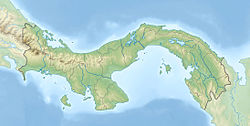From Wikipedia, the free encyclopedia
Geologic formation in Panama
The Cucaracha Formation (Tca)[1] is a geologic formation in Panama. It preserves vertebrate and plant fossils dating back to the Neogene period; Early to Middle Miocene epochs (Hemingfordian).[2] Fossils of the crocodylian Centenariosuchus, the turtle Rhinoclemmys panamaensis and the artiodactyl Paratoceras have been found in the formation.[3]
The Cucaracha Formation is approximately 125 metres (410 ft) thick,[4] and dated to 19 to 14 Ma.[5]
Fossil content
|
|
|
|
Color key
|
|
Notes
Uncertain or tentative taxa are in small text; crossed out taxa are discredited.
|
Mammals
Bats
Carnivorans
Ungulates
Reptiles
Plants
See also
References
- ^ Geologic Map, 1980
- ^ Cucaracha Formation at Fossilworks.org
- ^ Centenariosuchus at Fossilworks.org
- ^ Kirby et al., 2008, p.9
- ^ Kirby et al., 2008, p.11
- ^ Morgan, Gary S.; Czaplewski, Nicholas; Rincon, Aldo F.; Bloch, Jonathan Ivan (November 2023). "A new early Miocene bat (Chiroptera: Phyllostomidae) from Panama confirms middle Cenozoic chiropteran dispersal between the Americas". Journal of Mammalian Evolution. 30 (4): 1–31. doi:10.1007/s10914-023-09690-4.
- ^ a b c d e f g h Macfadden, Bruce J. (2006). "North American Miocene Land Mammals from Panama". Journal of Vertebrate Paleontology. 26 (3): 720–734. ISSN 0272-4634.
- ^ a b Macfadden, Bruce J.; Kirby, Michael X.; Rincon, Aldo; Montes, Camilo; Moron, Sara; Strong, Nikki; Jaramillo, Carlos (March 2010). "Extinct peccary "Cynorca" occidentale (Tayassuidae, Tayassuinae) from the Miocene of Panama and correlations to North America". Journal of Paleontology. 84 (2): 288–298. doi:10.1666/09-064R.1. ISSN 0022-3360.
- ^ PROTHERO, DONALD R. (2021-05-28). THE SYSTEMATICS OF NORTH AMERICAN PECCARIES (MAMMALIA: ARTIODACTYLA: TAYASSUIDAE). New Mexico Museum of Natural History and Science.
- ^ Rincon, Aldo F.; Bloch, Jonathan I.; Macfadden, Bruce J.; Jaramillo, Carlos A. (2015-09-03). "New early Miocene protoceratids (Mammalia, Artiodactyla) from Panama". Journal of Vertebrate Paleontology. 35 (5): e970688. doi:10.1080/02724634.2015.970688. ISSN 0272-4634.
- ^ a b Hastings, Alexander K.; Bloch, Jonathan I.; Jaramillo, Carlos A.; Rincon, Aldo F.; Macfadden, Bruce J. (2013). "Systematics and biogeography of crocodylians from the Miocene of Panama". Journal of Vertebrate Paleontology. 33 (2): 239. doi:10.1080/02724634.2012.713814. ISSN 0272-4634.
- ^ Salas-Gismondi, Rodolfo; Moreno-Bernal, Jorge W.; Scheyer, Torsten M.; Sánchez-Villagra, Marcelo R.; Jaramillo, Carlos (2019-06-18). "New Miocene Caribbean gavialoids and patterns of longirostry in crocodylians". Journal of Systematic Palaeontology. 17 (12): 1049–1075. doi:10.1080/14772019.2018.1495275. ISSN 1477-2019.
- ^ a b c d e Cadena, E.; Bourque, J.R.; Rincón, A.F.; Bloch, J.I.; Jaramillo, C.A.; MacFadden, B.J. (2012). "New turtles (Chelonia) from the late Eocene through Late Miocene of the Panama Canal Basin". Journal of Paleontology. 86 (3): 539–557.
- ^ Rodriguez-Reyes, Oris; Gasson, Peter; Thornton, Carolyn; Falcon-Lang, Howard J.; Jud, Nathan A. (2017-12-06). "Panascleroticoxylon crystallosa gen. et sp. nov.: a new Miocene malpighialean tree from Panama". IAWA Journal. 38 (4): 437–455. doi:10.1163/22941932-20170178. ISSN 0928-1541.
- ^ Rodríguez-Reyes, Oris; Gasson, Peter; Falcon-Lang, Howard J.; Collinson, Margaret E. (November 2017). "Fossil legume woods of the Prioria-clade (subfamily Detarioideae) from the lower Miocene (early to mid-Burdigalian) part of the Cucaracha Formation of Panama (Central America) and their systematic and palaeoecological implications". Review of Palaeobotany and Palynology. 246: 44–61. doi:10.1016/j.revpalbo.2017.06.005.
- ^ Jud, Nathan A.; Nelson, Chris W. (May 2017). "A liana from the lower Miocene of Panama and the fossil record of Connaraceae". American Journal of Botany. 104 (5): 685–693. doi:10.3732/ajb.1700080. ISSN 0002-9122.
Bibliography

